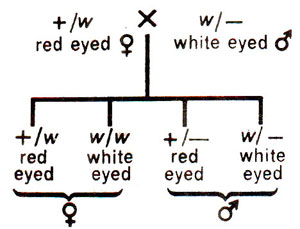The earliest record of point mutations dates back to 1791, when
Seth Wright noticed a lamb with unusually short legs in his flock of sheep. Wright thought that it would be worthwhile having a whole flock of these short legged sheep, which could not get over the low stone fence and damage the crop in the adjacent fields. In the successive generations, this trait was transferred and a line was developed where all sheep had short legs. This character resulted from a recessive mutation and the short legged individuals were homozygous recessive. Once this mutation occurred in a particular cell, this will be carried in all the cells descending from this parent cell. This point mutation was discovered at a time when the science of genetics did not even have its birth. The short legged breed of sheep was known as
Ancon breed.

Fig. 21.1. Appearance of a white eyed ♂ fly in a cross red eyed ♀ x while eyed ♂
The scientific study of mutations started in 1910, when T.H.
Morgan started his work on fruitfly,
Drosophila melanogaster, and reported white eyed male individuals among red eyed male individuals. Later it was found that the gene for this character is located on sex chromosome (X-chromosome) and expresses itself in a male individual (male individuals have one X-chromosome and one Y-chromosome; the female has two X-chromosomes). When these rare white eyed males were crossed to their sister red eyed females, white eyed females could also be obtained in some cases proving that the females involved were heterozygous (Fig. 21.1).

Fig. 21.1. Appearance of a white eyed ♂ fly in a cross red eyed ♀ x while eyed ♂
After the discovery of white eyed mutant, a thorough search for mutants was made by Morgan and his co-workers in
Drosophila and about 500 different mutations were observed by geneticists all over the world. This search of mutations in
Drosophila was accompanied with mutation work in other organisms also e.g. maize, snapdragon, rodents, pea, fowl, man, etc. However, in the last 40 years, increasing interest has been observed for mutations in microorganisms, like
Neurospora, bacteria (
Escherichia coli)and bacteriophages, since these materials have been found to be very suitable for mutation work.





